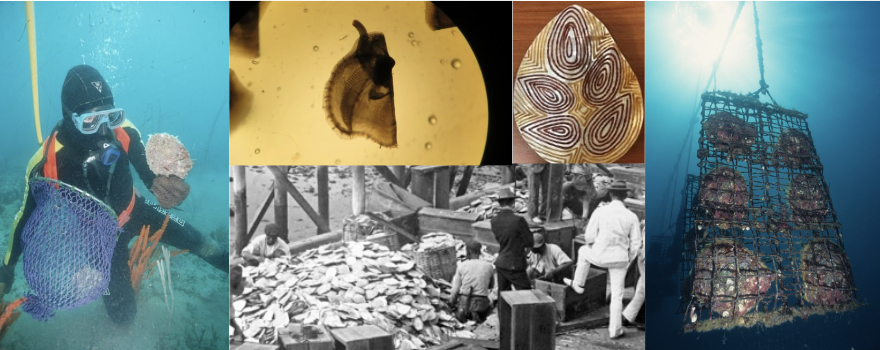Pearls on a Mission

ORIGIN - AUSTRALIA
The northwest shores of Australia mark the southern limit of the natural beds of Pinctada maxima, the largest of all pearl-bearing oysters. These oysters are responsible for producing the renowned South Sea Pearls, a prized gem that continues to thrive thanks to unique resource management practices.
Pinctada maxima oysters have existed for around 14 million years and have been traded by Indigenous Australians for millennia. However, it wasn’t until early settlers made Broome the world’s pearling centre in the early 1900s that the industry truly flourished. Aboriginal Australians, alongside Japanese and Southeast Asian immigrants, worked as divers and deckhands in an industry that survived two world wars and resource depletion, only to eventually decline as plastic replaced nacre in the button-making industry.
William Saville, a British biologist who pioneered oyster nucleation for pearl production, passed this skill on to two visiting Japanese individuals—one of whom later married Mikimoto’s daughter. This exchange led to the first cultured pearl farm opening in Kuri Bay in 1956, giving birth to a new industry.
Today, Australia remains the only pearling sector to have its fisheries quota system certified by the Marine Stewardship Council (MSC) as of 2017. Most Australian South Sea Pearls are still cultivated in wild-collected adult shells, allowing for second and sometimes third nucleation (seeding), which results in larger pearls compared to those produced in hatcheries in countries like Indonesia and the Philippines. The Australian pearling industry has since consolidated and is largely in the hands of third- and fourth-generation families, preserving its heritage.
At Onegemme, we curate single origin cultured and natural pearls from all corners of the world. Unlike the typical practice of mixing and consolidating harvests to increase matching opportunities—thus losing the story behind each pearl—we focus on preserving the unique history of each pearl. Every pearl, matching, and strand we offer is uploaded to the Provenance Proof blockchain platform, ensuring its story is passed down for generations to come.
IMPACT - CLIMATE

The quest for the perfect pearl has long captivated generations of pearl divers and farmers. While pearl cultivation has made these living gems more accessible, climate change is increasingly complicating the production of high-quality pearls. Pearls and molluscs serve as indicator species, capturing climate change markers within their growth. A Two Life Cycle Analysis (LCA) conducted in 2023 revealed that the climate impact of saltwater pearls ranges from just a few grams to a few kilos of CO2 equivalent per pearl harvested, placing them among the lowest-carbon gemstones.
However, the environmental impact of marine pearl farming can vary significantly depending on the species and location. The low carbon footprint of saltwater cultured pearls is offset by the many ecological benefits that the molluscs provide within their ecosystems. Best practices in marine pearl farming can, Reduce emissions from a few kilos to just a few grams of CO2-eq per pearl, increase nutrient bio-extraction, particularly phosphorus and nitrogen, improve the abundance and diversity of marine life and offer alternative livelihoods to local communities.
Oysters not only capture carbon dioxide but also enhance water quality and foster thriving ecosystems. Crushed shells and meat are used to enrich soil, create cement, and seed reefs. Furthermore, nacre has long been valued for ornamental uses, while its active ingredients are utilized in cosmetics and medical applications. The ongoing rise in ocean temperatures and ocean acidification, however, remain significant threats to both molluscs and pearl growth.
At Onegemme, we support our suppliers on their Environmental, Social, and Governance (ESG) journey, with 1% of our sales proceeds directed towards pearl-related research programs. Until a global impact certification framework is established, we assess our suppliers based on the regulatory environment they operate within, their environmental commitments, and how they evaluate and mitigate their impact.
QUALITY - SIZE

Only a few natural mollusc beds have survived the combined effects of overfishing, industrial pollution, and now, climate change. Today, most pearls are cultivated in molluscs whose parents were selectively chosen for their superior qualities and initially grown in controlled environments.
It takes three molluscs to produce a saltwater cultured pearl. A nucleus, carved from a freshwater mussel, is carefully inserted into a host oyster along with a piece of mantle (known as saibo in Japanese) from a donor oyster. The donor oyster typically determines the pearl's colour, while the metabolism of the host, access to nutrients, and cultivation time influence the size. The shape, lustre, and surface quality are largely dependent on the skill of the technician.
Each oyster species produces pearls of different sizes, with South Sea pearls being the largest and Akoya pearls being the smallest on average for saltwater pearls. Cultured pearls are measured by their length, width, and height in millimetre increments, with two decimal places for single pearls. For graduated strands, the largest and smallest pearls determine the size range. Larger pearls are not always better; however, all things being equal, value tends to increase with size. Ultimately, design and ideal proportions usually drive preferences in selecting pearls.
At Onegemme, we describe our pearls using a universal classification system based on the Gemmological Institute of America's (GIA) 7 Pearl Value Factors and the CIBJO pearl guide. Additionally, we use a simplified grading system that combines lustre, surface quality, and nacre thickness. Fine pearls are collectors' items, ideal for haute couture jewellery and one-of-a-kind creations, while jewellery-grade pearls are best suited for repeat designs and strands.
Sunday
Monday
Tuesday
Wednesday
Thursday
Friday
Saturday
January
February
March
April
May
June
July
August
September
October
November
December



